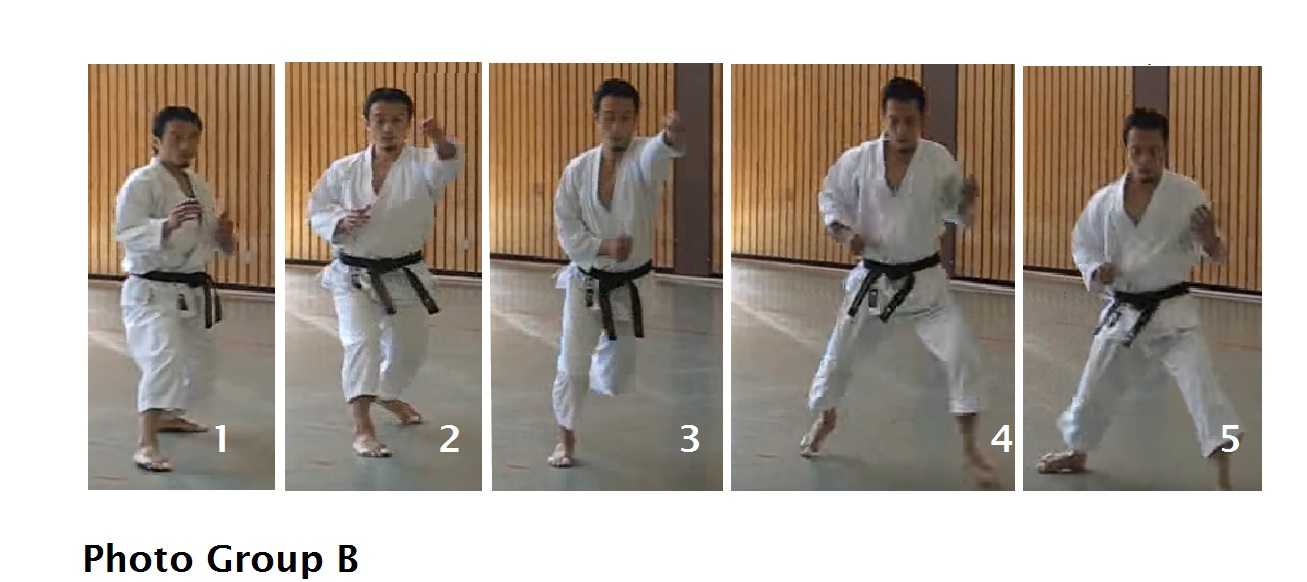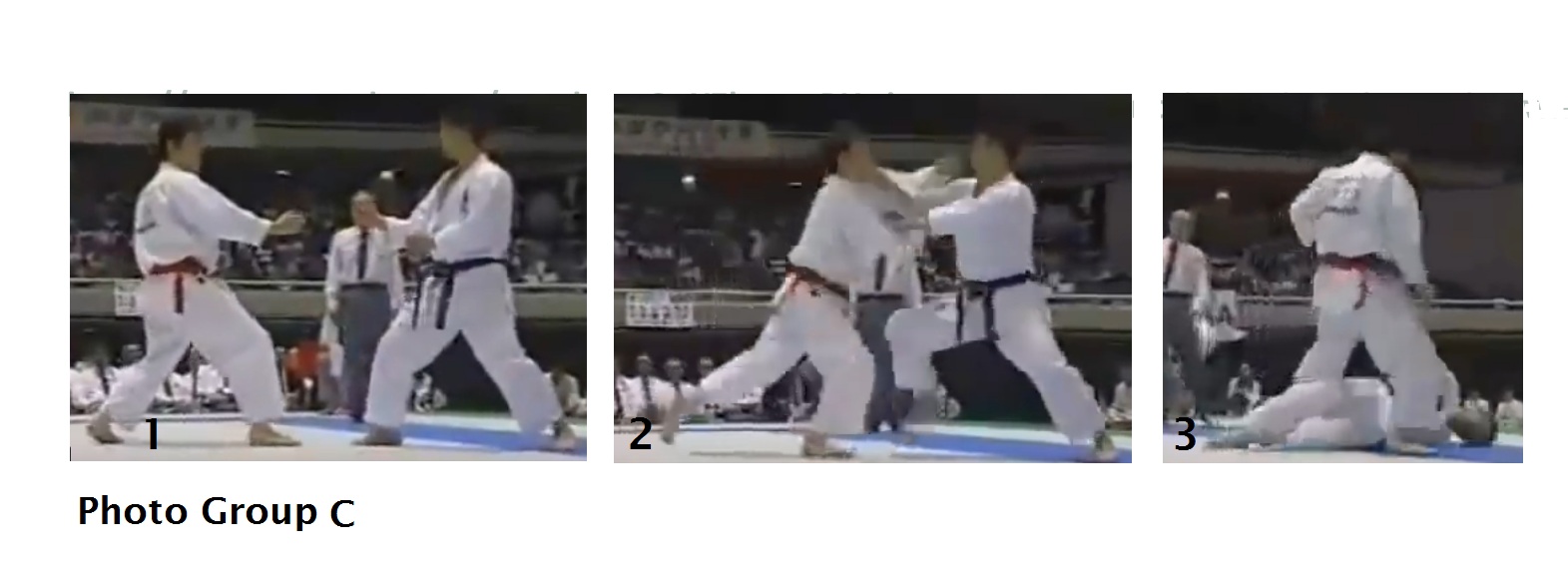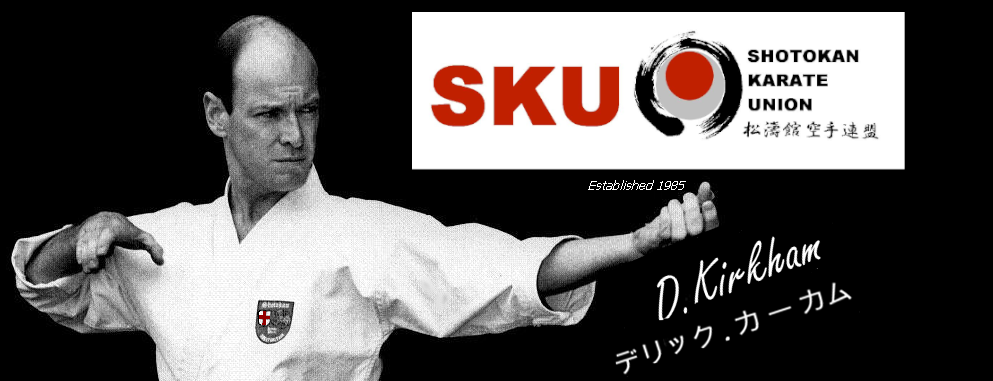"Coaching The SKU Way!" Official SKU Coaching Resource
May 2012 Issue 47 SKU Quarterly Magazine
Okuri-Tsuki Deadly Technique or does it even exist?
by Derick Kirkham
What is Okuri-tsuki? Hopefully this article will unravel any misconceptions that surround this neglected and under used technique.
The word Okuri was initially referred to as meaning (to slide) by Judo-ka. Although it has many meanings in the Japanese language, when linked with other words. For example, to send, to bring, to follow, to live through. And initially the emphasis and use of the footwork concept (to slide) is probably the main reason why it is still occasionally, yet wrongly confused with and mistaken for as being a form of Nagashi-tsuki (flowing punch).
Let me explain. Many of the Japanese instructors in the early days came to Karate after having had a period of study in and attaining rankings in other oriental arts such as Judo and Kendo.
Judo have a technique called Okuri-ashi-barai, which is (the sliding leg sweep), while Kendo have a specialised footwork technique named Okuri-ashi (sliding leg) see Fig 1.
Okuri-ashi (sliding leg) is a key part of Kendo's tactical armoury. This Shizen-tai footwork technique is important in Kendo because it permits the Kendo-ka to move extremely quickly forwards and backwards with only the minimum of "dead time". We were taught that this is a highly pertinent concept to bear in mind as it is very relevant to understanding the tactical essence of the Karate technique Okuri-tsuki.
Combining the previous influences from other Martial Art forms that the early Japanese instructors had, with the complexity and too often ambiguity of the Japanese language. The reluctance of some, not all of the Japanese instructors to give detailed explanations to their Gaijin students, of the names, concepts and meaning of every technique that they displayed, and taught us. In their defence it was due in the main to their limitations in speaking the English language and our Nihon-Go limitation in their early pioneering days. These factors could go a long way in explaining some of the controversy and confusion that surrounds this very useful and powerful technique.
While the preparatory sliding footwork of the technique is a key facet to the success of the technique. As we will explore later in this article. It was several years later that Mr Kanazawa offered his definitive explanation of the technique. when he gave the translation of "follow through punch".
Okuri-tsuki is a punching technique that is delivered and reaches its target between the firm placements of ones launching and landing stances. Connecting with its desired target area whilst one’s body mass is still on the move. The in transit nature of the technique is what makes it difficult for some people to identify, classify, and perform. Equally it is that in transit nature, the maximising of ones accelerated forward moving momentum which makes it such a powerful hard hitting technique.
It's not a variation of Oi-tsuki, Kizami-tsuki, Nagashi-tsuki nor Gyaku-tsuki, but understandably it can and is often mistaken for these techniques, because it does resemble a poorly co-ordinated Oi-tsuki, or an over stretched Gyaku-tsuki, where the rear foot isn't firmly rooted to the floor upon the fists impact with the target area. Therefore, identifying it for some observers is often a difficult task, as its characteristic delivery speed masks what is actually going on. Its runaway freight train effect is dependent upon a couple of things. The timing of the launch of the punch. In other words, if there is any assistance from the forward projection of ones opponent to factor in, and of course, the proficiency of the performer.
It's not a new technique more than it is a neglected one and it has been an over looked technique for many reasons, some of which were explained above. In my experience its Kihon practice is neglected because it doesn't obviously appear in any kata nor is it a grading syllabus requirement of any Traditional Shotokan Karate-do Organisation. And due to its more agricultural and practical functionality it has also been over-looked by many, not all in the modern sporting arena, as it is believed to be too brutal and it lends itself more for use in Jissen and Jiyu-Kumite; therefore, it poses the question as it is too easy to mistake it for an abbreviated form of or quirky variation of some other tsuki. That's why this reworked rendering of the Irish philosopher, George Berkeley’s philosophical question, is raised. "if a technique isn't practiced often enough and nobody observes it, then does it exist?"
Among the accomplished exponents of Okuri -tsuki, was the late Steve Cattle. Who was by the way, instrumental in my initial introduction to the benefits of Okuri-Tsuki. Others worthy of note are the late Mr Kase and Mr Enoeda, and in the new generation of Japanese Instructors are people such as T.Naka and T.Yamaguchi. While the overall technique is somewhat Kamakaze looking in appearance, the underlying tactics employed are of equal importance to its success as the mechanics of the technique itself.
The tactics involved are; selecting the correct mind set prior for delivery, ones timing, line and direction are all key. Whilst the technique can be delivered using a permutation of various tactics. The most commonly used and most devastating results can be achieved by using a combination mind set of "Ikken Hisatsu", "Sen no Sen" and "Irimi". Therefore, the delivery of the technique in the following examples are delivered directly in the forward direction.
In Martial Art circles Ikken Hisatsu, is commonly believed to mean (to kill with one blow), this mind set concept is yet another area that is misunderstood, it is over quoted and it is overplayed due to the nature of and the wholesale delusional acceptance of its alluring Martial Arts translation.
It does not have to be and in reality rarely does end in the death of the opponent with one blow as the common translation would misleadingly suggest. In common Japanese parlance Ikken Hisatsu means something similar to (kill two birds with one stone). Therefore, for the purpose of this article and for brevity, if one accepts that in this instance "to kill with one blow" actually means "to make the technique that you are about to deliver the decisive technique that will end the conflict". By using this definition for the mind-set concept of "Ikken Hisatsu" then one is actually asking the performer to have 100% commitment to and belief in the success of the technique that they are about to deliver and for them to hold onto that thought as paramount in their thinking throughout the techniques performance.
Earlier Steve Cattle was mentioned as an accomplished exponent of this technique. And if you were around during his best competitive years then you would have seen exactly what 100% commitment in the delivery of and in the belief of the success of the technique looked like. The technique can be delivered using the Go no Sen concept which is "seizing the initiative later" by blocking then countering after their attack has been thrown. But commonly Okuri-tsuki is seen as in these examples by using Sen no Sen, "seizing the initiative early". Which is not necessarily where one makes the first move but more often involves one intending to counter precisely at the same time that your opponents attack is being launched. However, in actuality that means as soon as your reflex action allows you to respond once you register that their attack has been initiated. In other oriental fighting arts, there are various lines taken by the attacker and the defender. In Aikido in particular there are a couple of approaches that are worthy of note. They are Tenkan which is to convert, or divert either your or your opponents projected momentum. This is more complex than, but almost similar in nature to Karates' Tai-Sabaki. Then there is the very potent tactic of Irimi. Which is the entering straight into a technique approach. Where one can strike at an opponent effectively with great force, by combining their attacking momentum with one's own forward momentum, as is the intention in this example. Where does the "sliding in" take place, in Okuri-tsuki? After one observes the technique. Then one could never describe it as being of a sliding motion. As it loudly screams out that it is more of a high octane, high speed and powerful driving collision of a movement. Where the puncher really has "followed through" with their technique.
The "sliding in" occurs after Kamae-te and refers to the essential preparatory footwork of Okuri-ashi, Fig 1.
It is used to gain territorial advantage and to ensure that the correct launching distance is obtained for this long range Tsuki technique. Therefore, "sliding in" doesn’t describe the stand alone punch, but it describes the tactical footwork that is used. The footwork which is taken from other fighting arts. The tactic of using the sliding leg (Okuri-ashi).
What makes Okuri-tsuki so effective? Is it the unusual nature of its timing and delivery, which generates high speed with the minimum amount of "dead time"? Probably! But as in every walk of life there is a payoff to be made for every gain. In this example the payoff for increased speed and reduced "dead time" is a loss in stability upon impact with the target. As the impact point generally occurs when one is stood on one leg and whilst in mid-flight. This loss in stability however minor, is due to the body's full commitment and its "follow through" motion. When compared to that of say a conventional Oi-tsuki or Gyaku-tsuki.
So with the tactics firmly in place and the correct distance to launch ones Okuri-tsuki gained by using Okuri-ashi. Let's take a stage by stage approach as to describing the execution of the technique itself.
As we are using "Ikken-Hisatsu", "Sen no Sen" and "Irimi", we will therefore, be stepping forwards to deliver the technique.
1. Assume a right foot forward Kamae-te. Fig 2
2. Use Okuri-ashi to gain advantage to ensure that the correct launching distance is obtained. Fig 1
3. Quickly rotate the hips from Hanmi through to Shomen and begin to punch Jodan-tsuki with the left hand, just slightly before you start to move the left leg (Do-Kyaku) forwards as in Fig 2A
So far you can see why initially it may look like a static but poorly executed Gyaku-tsuki. However, where in Gyaku-tsuki one is expected to keep the body perpendicular throughout the hip rotation, and any forward projection and extension is achieved by
a) the extent of the hip rotation
b) the distance the stance travels
c) the bending of the knee of the front leg.
Whereas in Okuri-tsuki, ones forward projection is achieved by leaning slightly forward into the target and the "follow through" as in Fig 2B.
Note unlike Gyaku-tsuki, the co-ordinated Hikite and the firmly planted back foot is not present throughout.
4. Fig 2C Shows a side view just prior to impact. This is the phase where the left leg (Do-Kyaku) starts to catch up by driving towards ones over stretched centre of gravity point.
5. The left leg (Do-Kyaku) has now reached the body's balanced centre of gravity point and the body is perpendicular, it is at this point when the explosive collision impact of the punch occurs as in Fig 2D
Note how the left leg (Do-Kyaku) is still moving and not on the floor.
6. After the impact in the basic form of the technique one should snap back the left hand and firmly place down the left leg (Do-Kyaku). Variants of the snap back are employed if the use of a follow on technique requires it Fig 2E
7. The snap back of the left hand is in readiness. Assume a left leg forward Kamae-te.
Photo Group A 1-8 demonstrates Okuri-Tsuki with the follow up technique of a highly destructive leg sweep performed with Ikken-Hisatsu in mind, as always by K.Enoeda.
Note
How much the front left foot moves forward in photos 1-2 gaining distance prior to the launching of the punch.
How at the impact point in photo 3 his right foot is off the ground.
And is still on the move forward in photo 4.
In this example the right foot will not land, as it will used to deliver a leg bar to execute a powerful double leg sweep followed up with Otoshi-Tsuki.
Photo Group B 1-5 Displays all the principles explained in the Fig : 2 example.
Photo Group C 1-3 Is a Display of the brutal effectiveness of the runaway steam train effect of a perfectly timed and distanced Okuri-Tsuki.
The puncher has made his distance on his opponent not seen in this photo sequence. Nevertheless, the Okuri-Tsuki technique is recorded as it makes contact. And the devastating end result can be seen.
Photo Group D 1-3 Although the Fighting Art may be different and the technique will not carry the same name, the physics, the theory and the end result however, remains exactly the same.
Photo 1 shows the total commitment of the body to the techniques delivery as it approaches the impact point. Notice that the arm is already at full extension.
Photo 2 shows the impact point. By the way this particular punch was responsible for breaking the jaw of the durable and very tough competitor Ken Norton.
Photo 3 shows that there is very little pull back of the technique after impact and the back leg of M.Ali has still not caught up the forward projection of his committed technique.
This article will have introduced Okuri-tski to some people but I hope it has stimulated enough interest in Okuri-tsuki with all readers so that they experiment with it in their personal training regime.
Although the objective of the article was to clear up some of the mysteries and misconceptions surrounding Okuri-tsuki. I invite all of you to conduct this simple experiment. Which I first saw demonstrated by Masahiko Tanaka. I firmly believe that it may help you as it did me, to fully appreciate and physically feel the advantages of “a moving mass” impact technique. Understanding the theory behind Okuri-tsuki can add to its overall effectiveness and enjoyment.
So then if you are game, then try this simple test.
1: Stand in a left leg forward Zenkutsu-Dachi
2: Position yourself close to a wall and extend the right arm out so that the fist of your right hand is firmly making contact with the wall.
3: Then push with the right arm into the wall constantly and experience what it feels like. In other words do not put on and ease off the pressure you are putting through the arm and fist during the experiment.
4: Next, without moving from the previous position, just lift the foot of the left leg. Feel how your mass is being pulled further into the wall, i.e. into the would be target. This is simply because the bodies mass is now unsupported and is subject to gravitational pull. Thus simulating the bodies mass being on the move. It simulates a snapshot taken whilst making contact with the target, just a fraction of a second prior to landing your mass through the foot of the moving leg (Do-Kyaku), exactly as you would experience it with a correctly delivered Okuri-Tsuki.
Until next time
Good Luck and Good Practice.





Video 1
